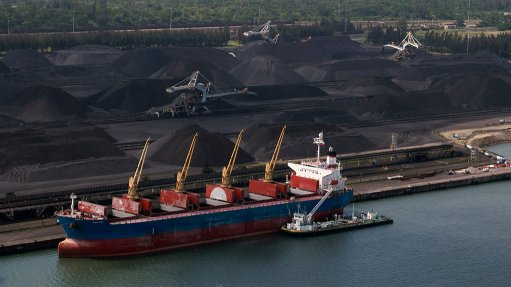
RECORD COAL EXPORTS Last year’s total exports amounted to 70.8-million tons
South Africa’s Richards Bay Coal Terminal (RBCT) attributes its record-breaking 2013 performance to the initiatives recently undertaken by the company to improve the country’s coal supply chain.
The RBCT reports that this year’s performance is expected to improve, reflecting further improvements in the supply chain.
Last year, a record 70.8-million tons of coal passed through the RBCT, two-million tons more than in 2012.
The RBCT reports that its previous record in export tonnage was in 2005, when 68.72-million tons passed through the terminal.
TheRBCT says its communication and coordination with State-owned freight-logistics group Transnet Freight Rail (TFR) has improved as a result of the joint planning and coordinating of operational issues.
Last year marked the first phase of an improvement project requiring the RBCT to focus on stabilising and improving internal efficiencies.
The second phase of the supply chain improvement project will involve realising the full benefits of TFR’s Shongololo initiative, which involves rail wagons bypassing the Ermelo rail yard and shipping coal directly to the RBCT. The wagons then embark on the same shortcut back to the mines, thereby reducing cycle times.
Setbacks
Meanwhile, the RBCT suspended all operations, including the export coal train service, following a power failure at the end of January.
The electrical failure was caused when the uMhlatuze municipality reported electrical faults on the two electricity cables that supply the Hydra electricity substation, which supplies the RBCT with power.
However, during the power failure, the general freight business continued unhindered.
A joint operation between TFR, the RBCT, State-owned power utility Eskom and the uMhlatuze municipality ensured that the system was up and running again by the first week of February.
Rail operations were operating normally again within 48 hours after electricity had been restored. At the time, the RBCT had 3.83-million tons of stock in its terminal, while 28 ships remained at anchorage, waiting to load 3.1-million tons.
Once electricity had been restored at the RBCT, shiploading operations started with a three-ship loader schedule. Once the rail network had stabilised, the RBCT returned to its normal four-ship loading schedule.
Based on the vessel queue at the time and taking into account the RBCT’s capacity of 91-million tons yearly, operations at the RBCT are expected to return to normal by March 31.